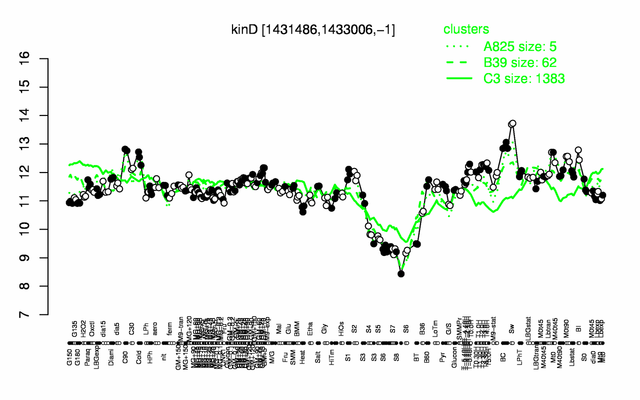Difference between revisions of "KinD"
| Line 146: | Line 146: | ||
=References= | =References= | ||
'''Additonal publications:''' {{PubMed|21622736}} | '''Additonal publications:''' {{PubMed|21622736}} | ||
| − | <pubmed>10094672,11069677,20689749 , 21097618 22074846</pubmed> | + | <pubmed>10094672,11069677,20689749 , 21097618 22074846 22716461 </pubmed> |
[[Category:Protein-coding genes]] | [[Category:Protein-coding genes]] | ||
Revision as of 16:32, 22 June 2012
- Description: two-component sensor kinase, phosphorylates Spo0F, part of the phosphorelay, checkpoint protein that links sporulation initiation to biofilm formation
| Gene name | kinD |
| Synonyms | ykvD |
| Essential | no |
| Product | two-component sensor kinase |
| Function | initiation of sporulation |
| Interactions involving this protein in SubtInteract: KinD | |
| Function and regulation of this protein in SubtiPathways: Phosphorelay | |
| MW, pI | 56 kDa, 6.745 |
| Gene length, protein length | 1518 bp, 506 aa |
| Immediate neighbours | eag, mhqR |
| Get the DNA and protein sequences (Barbe et al., 2009) | |
Genetic context 
This image was kindly provided by SubtiList
| |
Expression at a glance PubMed
| |
Contents
Categories containing this gene/protein
protein modification, transcription factors and their control, phosphorelay, membrane proteins, phosphoproteins
This gene is a member of the following regulons
The gene
Basic information
- Locus tag: BSU13660
Phenotypes of a mutant
deletion of kinD suppresses the sporulation defect of matrix mutants, while its overproduction delays sporulation PubMed
Database entries
- DBTBS entry: no entry
- SubtiList entry: [1]
Additional information
The protein
Basic information/ Evolution
- Catalyzed reaction/ biological activity:
- autophosphorylation, phosphorylation of Spo0F, regulates the onset of sporulation by inhibiting the activity of Spo0A until matrix, or a component therein, is sensed PubMed
- dual role as a phosphatase or a kinase, activity is linked to the presence of extracellular matrix in the biofilms PubMed
- mainly active in the younger, outer regions of a colony (with KinC) PubMed
- Protein family:
- Paralogous protein(s):
Extended information on the protein
- Kinetic information:
- Domains: two transmembrane segments, C-terminal histidine phosphotransferase domain
- Modification: autophosphorylation on a His residue
- Cofactor(s):
- Effectors of protein activity:
- Localization: membrane
Database entries
- Structure: 3FOS
- UniProt: O31671
- KEGG entry: [2]
- E.C. number:
Additional information
Expression and regulation
- Operon:
- Sigma factor:
- Regulation:
- Regulatory mechanism:
- Additional information:
Biological materials
- Mutant:
- Expression vector:
- lacZ fusion:
- GFP fusion:
- two-hybrid system:
- Antibody:
Labs working on this gene/protein
Your additional remarks
References
Additonal publications: PubMed